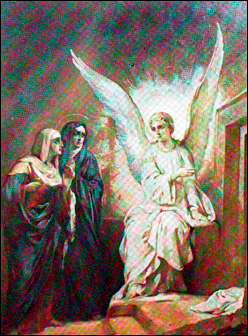
On the second Sunday after Pascha the Church commemorates the holy Myrrh-bearing Women – those extraordinary women whose burning love and devotion to Christ surpassed even that of His closest disciples, who fearfully sat behind locked doors while the women, bearing aromatic myrrh, fearlessly went out early in the morning, while it was still dark outside, to the tomb of Christ, where they were the first to hear the joyous news of Christ’s Resurrection and later to see the risen Christ Himself.
At first glance it may seem that this narrative concerning the myrrh-bearing women simply describes a historical moment in Christ’s life on earth, while the women themselves are presented to us by the Church as a symbol of love and devotion to Christ. But that is only partly true. In reality the holy women are a most concrete example to us of how to live and act in our own times.
You may well ask: what is there in common between our time and that of the myrrh-bearing women? Nearly 2,000 years have passed, and the world has seemingly changed to such an extent that it is unrecognizable: from a fairly simple life in the time of Christ we have evolved into a veritable maze of progress and technology. What can there be in common?
However, if we look closely, we will see that only the outward form of life has changed, while the inner form of our modern life is amazingly similar to those days of which we hear in the Gospel. Just as then, 2,000 years ago, Jerusalem was ruled by pagans, so now we see the whole world ruled by neo-paganism, which exhibits itself in all the manifestations of the human spirit: culture, morality, the arts, interpersonal relations. Just as then the scribes and Pharisees kept the Jewish people fettered and distanced from God by means of an elaborate system of rituals supposedly prescribed by the law of Moses, so now the descendants of these Pharisees fetter all people and keep them away from God by the force of so-called public opinion, which mocks and denigrates religion and morality.
Just as then the scribes and Pharisees abused, reviled, and spat at Christ, so now their descendants abuse and revile Christ through unspeakable blasphemy in the arts and literature, through mockery of Christ in print, through the brainwashing of young minds into godlessness and atheism. Just as then the pagan Roman soldiers crucified Christ, so now all peoples, having embraced neo-paganism, crucify Christ with their horrible sins, especially apostasy and sodomy.
Just as then the Apostle Peter renounced Christ “for fear of the Jews,” as the Gospel tells us, while the other disciples ran away and hid, so now many timorous Christians renounce their faith, while Christian churches, for the same fear of the Jews, betray Christ by becoming modernized and embracing ecumenism, where they give up their positions and negotiate with Christ’s persecutors and with the pagans.
Then, at the dawn of Christianity, small groups of faithful followers of Christ, who were the very first Christians, gathered in Jerusalem: these were all who had been healed by Christ; these were the newly-resurrected Lazarus with Mary and Martha and all who had witnessed the great miracle; these were all who believed in Christ as the Messiah. In our times, too, in the twilight of Christianity and human history, in our world lying in iniquity, there are similar small groups of Christ’s faithful followers: these are all true Orthodox Christians who have not embraced modernism, who have not perverted their faith, who have not entered into dealings with heretics and apostates.
And against this background we see before us the shining example of the myrrh-bearing women, indicating to us a specific course of action, indicating to us concretely how we – the last Christians – should live within the environment of apostasy which surrounds us.
Like the myrrh-bearers, we should not be afraid to step out into the darkness of the surrounding world, carrying with us the fragrance of good deeds, faith, love, and devotion to Christ. Like the myrrh-bearers, we should hurry to the tomb of Christ, which in our case is the church, and we should openly confess our faith without fearing mockery from those around us.
The myrrh-bearers were undaunted by the great stone which barred the entrance into the tomb; so should we cast off the great stone of worldly busyness which prevents us from going to church. The myrrh-bearers were undaunted by the thought of the Roman soldiers guarding the tomb; so should we disperse all our sinful passions, which tie us down to worldly vanities and bar our way to church.
In this manner, if we follow the wondrous example and the actions of the myrrh-bearing women, – we too, coming to church as they once came to the tomb of Christ, will hear the joyous news that…
Christ is risen! Truly He is risen!
Father Rostislav Sheniloff
|